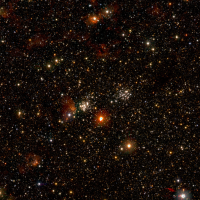A billion stars revealed

Astronomers have today released a picture containing more than one billion stars in our Milky Way galaxy. It combines data from two near-infrared1 telescopes – the UK Infrared Telescope (UKIRT) in Hawaii and the VISTA telescope in Chile - and is the result of a decade-long collaboration by astronomers at the University of Edinburgh and the University of Cambridge to process, archive and publish the prodigious quantities of sky survey data generated by these two telescopes.
Dr Phil Lucas from the University of Hertfordshire leads the UKIRT study of the Milky Way, and co-leads the VISTA study. He said: “The combined data on over a billion stars represent a scientific legacy that will be exploited for decades in many different ways. They provide a three-dimensional view of the structure of our spiral galaxy, the Milky Way, while also mapping several hundred nebulae where stars are being born. The VISTA data, in particular, is breaking new ground by showing how several hundred million stars vary in brightness over time."
The full image contains 150 billion pixels, and the detail it contains is only revealed by the three zoom levels, centred on G305, a large and complex star-formation region: the innermost zoom covers a tiny fraction of the full image, but still contains more than ten thousand stars.
Presenting the image at the UK-German National Astronomy Meeting in Manchester, Dr Nick Cross of the University of Edinburgh said: “This remarkable image is only one of the many outputs from the VISTA Data Flow System (VDFS) project2. VDFS data is being used by astronomers around the world and has led to great discoveries in many fields of astronomy, from the coolest known stars to the most distant quasars.”
“Sky surveys are an increasingly important part of modern astronomy. The data centres supporting them need expertise in both astronomy and the latest information technologies. These two surveys are generating great science now, and will continue to do so for decades ahead, thanks to the careful job we have done in processing, archiving and publishing their data.” Dr Bob Mann, leader of the Edinburgh team
Professor Jim Emerson of the Queen Mary, University of London, leader of the VDFS development project, added: “Processing and publishing the tens of terabytes of data from modern sky surveys is a demanding and specialised job. By funding expert data centre teams to do that, we left the rest of the community free to do astronomy with the final data products. This is a very cost-effective way to do science.”
Dr Mike Irwin, leader of the Cambridge team explained: “VDFS was conceived as a two-phase project. Initially we handled the UK Infrared Deep Sky Survey (UKIDSS) data from UKIRT, and that prepared us for the much larger data volumes to come from the VISTA sky surveys.”
Professor Steve Warren of Imperial College London is the UKIDSS Survey Scientist. He commented: “The UKIDSS team is being honoured at this conference through receipt of the Royal Astronomical Society Group Award. The great scientific productivity of UKIDSS has relied on the VDFS data products. More than 300 scientific papers have resulted from UKIDSS data. We just wouldn't have got anywhere with the science if we had been trying to process this mountain of data ourselves, individually.”
The UKIDSS survey is drawing to a close, and the focus of VDFS work is now on the sky surveys being undertaken with the VISTA telescope, operated by the European Southern Observatory (ESO) and located in Chile. The VISTA programme3 comprises six surveys targeting different areas of the sky and with different scientific goals:
- VISTA Variables in the Via Lactea (VVV) survey and the VISTA Magellanic Survey (VMC) focus on the stellar populations of the Milky Way galaxy and its immediate neighbours, the Magellanic Clouds, respectively.
- UltraVISTA, the VISTA Kilo-Degree Infrared Galaxy Survey (VIKING) and the VISTA Deep Extragalactic Observations Survey (VIDEO) study external galaxies.
- The VISTA Hemisphere Survey (VHS) includes the whole of the southern sky not covered by the other surveys, and has science goals from both stellar astronomy and extragalactic astrophysics.
VDFS is supporting five of the six surveys - VVV, VMC, VIKING, VIDEO and VHS - and is in the process of making the first public releases of data from them through the VISTA Science Archive (VSA)4 in Edinburgh.
Listen to Nick Cross speaking to the BBC about the information that went into making the picture.
Notes
[1] Near-infrared radiation is invisible to the human eye, but can be felt as heat on the skin in everyday life. It allows astronomers to probe regions of space, such as dust clouds in the Milky Way, that are opaque to visible light, and to identify objects that are too cold or too distant to emit much visible light.
[2] The VISTA Data Flow System (VDFS) project is a collaboration between the Wide-Field Astronomy Unit (WFAU) at the University of Edinburgh and the Cambridge Astronomical Survey Unit (CASU). CASU lead the data processing operations, and WFAU are responsible for the archiving of data products and their publication to the astronomical community.
[3] See VISTA Public Surveys programme for more details.
[4] VISTA Science Archive (VSA). The WFAU team responsible for the design, development and operation of the VSA comprises: Rob Blake, Ross Collins, Nick Cross, Nigel Hambly, Mark Holliman, Andy Lawrence, Bob Mann, Keith Noddle, Mike Read and Eckhard Sutorius.
This research was supported by the Science and Technology Facilities Council (STFC) and its predecessor the Particle Physics and Astronomy Research Council (PPARC).
All images courtesy of Mike Read (WFAU), UKIDSS/GPS and VVV.

